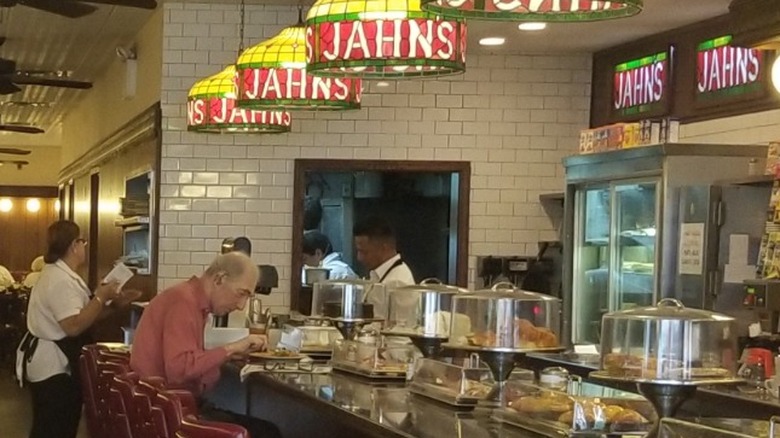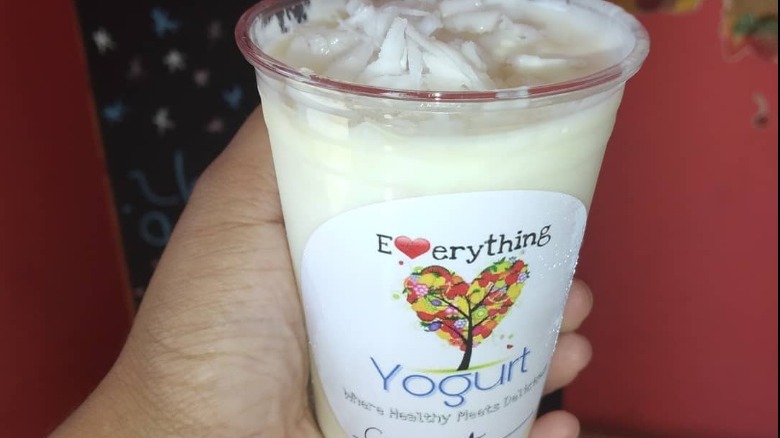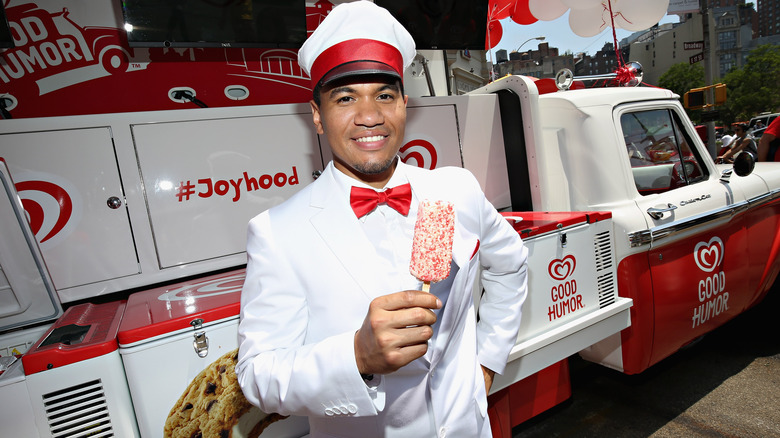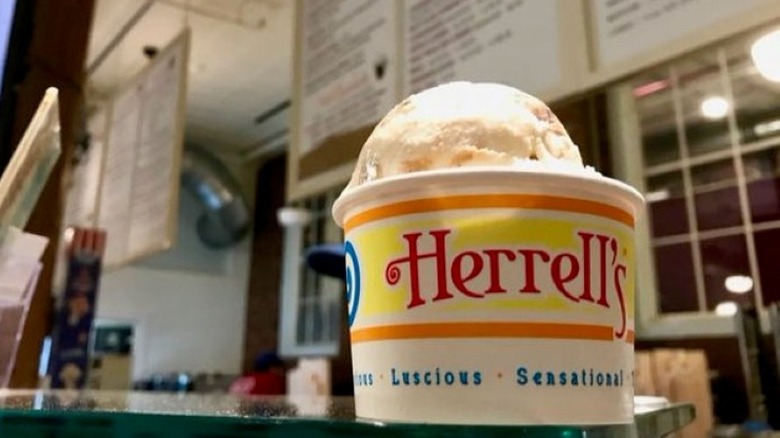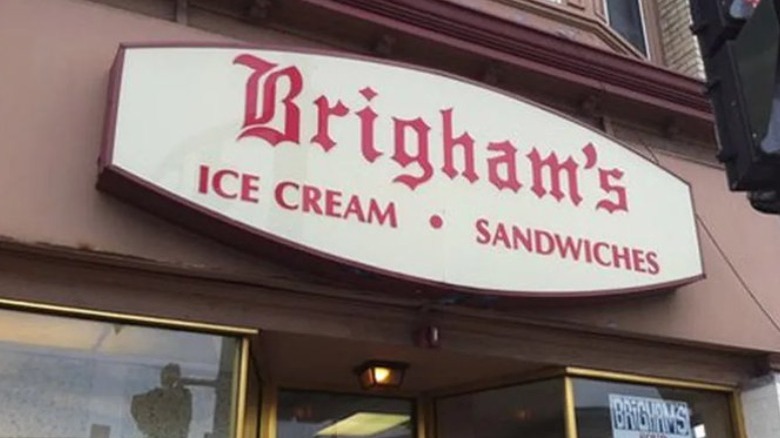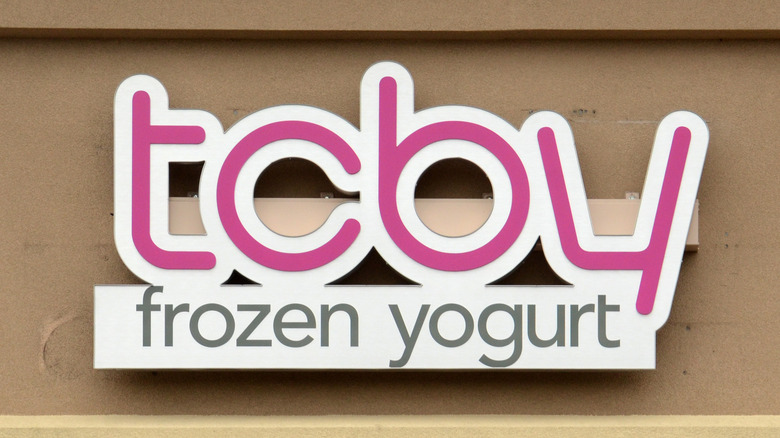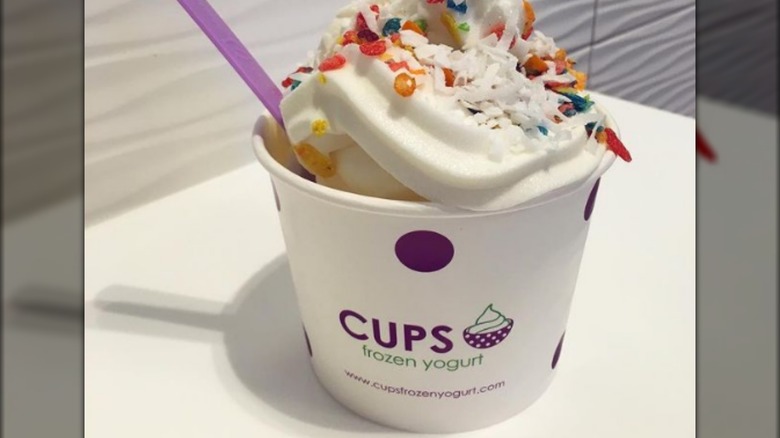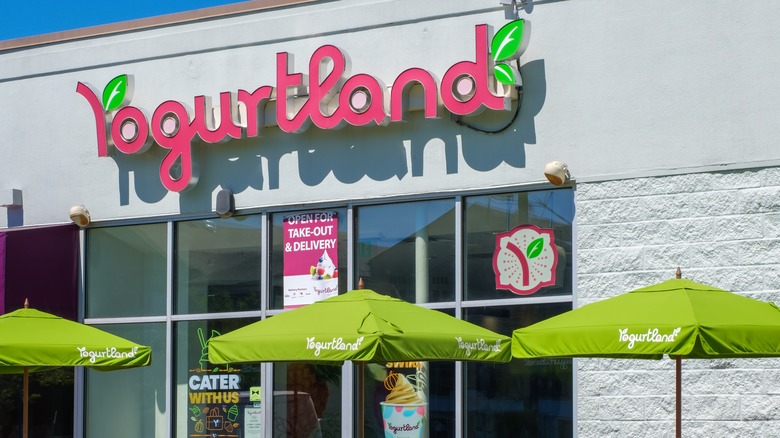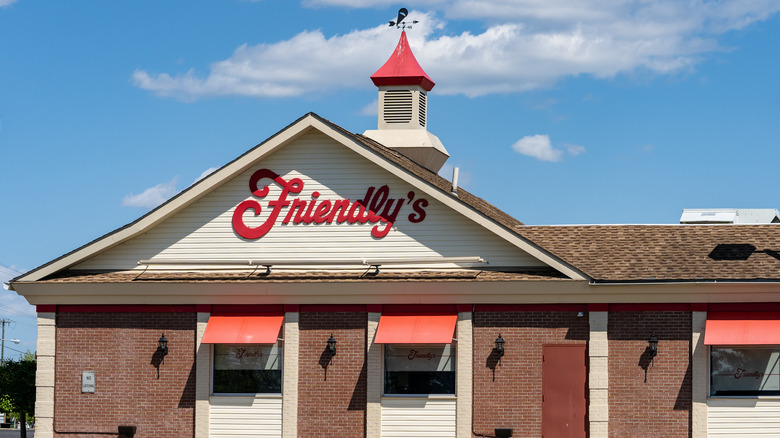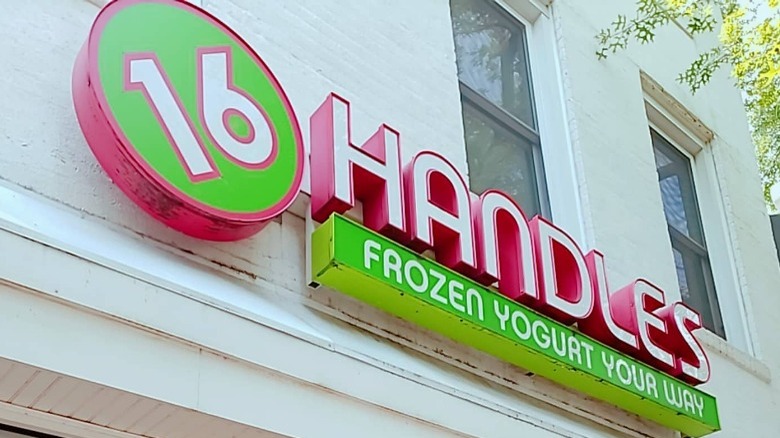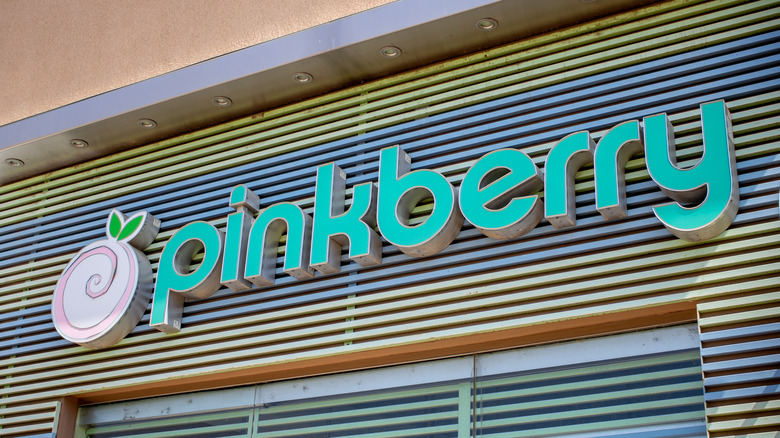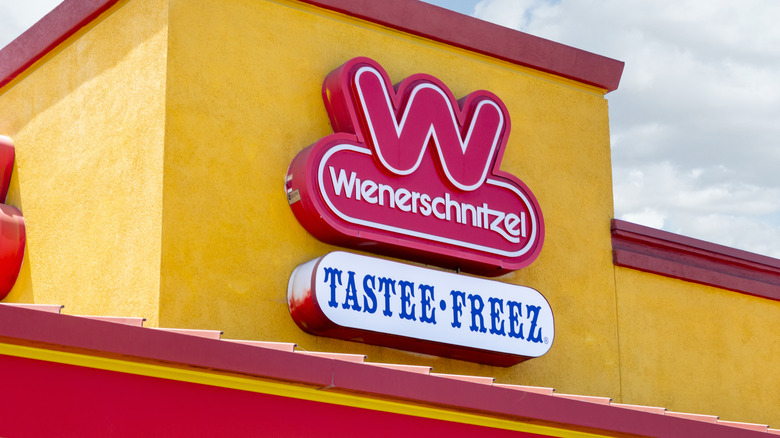Beloved Ice Cream Chains Struggling To Survive
Most of us have nostalgic happy memories of times spent with ice cream chains on hot summer days. But many of the places where we once ate ice cream and frozen yogurt have started to close. As companies saw the success of frozen treat franchises around them, they hopped on the trend until the market became oversaturated. And one can only eat so much ice cream.
A handful of companies selling ice cream and frozen yogurt have folded, but most have hung on in one way or another by adjusting to the changing times. Some, like Yogurtland, have opened restaurants with more than just desserts on the menu, while others like Cups Frozen Yogurt have added a variety of frozen options to the menu. Companies like Good Humor and Brigham's realized they needed to switch to selling only in grocery stores. Unfortunately, many companies haven't made enough changes to keep up with customer purchasing habits and have had to shutter locations. Several of these beloved ice cream chains continue to limp along, with the hope that their current strategy will be enough to keep them selling ice cream to the next generation. Only the future will tell.
Jahn's
John Jahn opened the first Jahn's in the Bronx of New York City in 1897 (via New York Business Journal). Once upon a time, you could find about 30 Jahn's locations throughout New York, New Jersey, and southern Florida (via Burger Beast). Now, there is only one Jahn's restaurant holding out in Queens, New York. Jahn's is famous for its Kitchen Sink sundae, which is large enough for a whole table of friends to share. Customers have fond memories of hanging out at Jahn's in high school and managing that one time to finish an entire Kitchen Sink with all their friends (via Facebook).
Nick Moukas, co-owner of the last remaining Jahn's in Queens, told the New York Business Journal that his father acquired the restaurant as a franchise in 1970. Moukas said that many Jahn's locations started faltering later that decade. "When Jahn's started, ice cream was a treat. Now there's more competition — frozen yogurt, Carvel, Baskin Robbins, and ice cream sold in grocery stores," he said. Moukas said that the remaining Jahn's restaurant has survived because his father converted it into a diner that serves breakfast, lunch, and supper. Offerings include everything from seafood and burgers to Greek and Italian specialties, per Grubhub. Plus, you can still order its incredible ice cream, which customers say tastes homemade (via Google).
Everything Yogurt
Everything Yogurt was the first chain to start selling frozen yogurt before those franchises became trendy, per The International Frozen Yogurt Association. The first Everything Yogurt location opened in New York in 1976. By the 1990s, it was the second-largest frozen yogurt chain, with nearly 300 stores. The company that owned Everything Yogurt evolved into Bananas Smoothies & Frozen Yogurt franchises. As of 2022, there's only one remaining Everything Yogurt store in New York City and one remaining Bananas Smoothies & Frozen Yogurt location on Staten Island in New York.
At the last remaining Everything Yogurt, you can purchase frozen yogurt in a cone, as a smoothie, in a cup with fruit, or in a milkshake. The store also sells lemonade, fountain sodas, and Frosties, which is a blend of fruit and ice (via Tripadvisor). For broader appeal, the shop has added pastries and soft pretzels to its offerings (via Google).
Good Humor
In 1920, Harry Burt became the first person to create a chocolate-covered ice cream treat on a stick. Once he realized he had something worth selling, he began sending white-clad Good Humor men out to deliver the frozen bars around neighborhoods. He started selling ice cream bars from 12 refrigerated ice cream trucks with bells. Interestingly, the first bells for the trucks came from his son's bobsled.
In 1950, 90% of its ice cream sales were from its fleet of 2,000 trucks (via Motor Trends). By the early 1970s, Good Humor was down to 1,200 trucks and was losing profits from rising fuel costs, insurance costs, union contract costs, and ice cream competitors, Motor Trends reported. In 1976, the company was one of the first to realize that selling ice cream through grocery stores was more profitable. Thus, it sold all its trucks and switched to selling its products in grocery stores.
You can still find Good Humor ice cream treats at local grocery stores, and some independent ice cream truck drivers may purchase them to re-sell. However, seeing an actual Good Humor ice cream truck is a rare occurrence these days. A few privately owned trucks appear at special events like antique car shows. While they may be selling Good Humor ice cream, the trucks don't belong to Good Humor (via Hagerty).
Herrell's Ice Cream and Steve's Ice Cream
Steve Herrell opened the first Steve's Ice Cream in Somerville, Massachusetts, in 1973. The store's claim to fame was its creamy and rich homemade ice cream. He was the first to introduce "Smoosh-ins," with "gourmet" ingredients like Reese's Peanut Butter Cups and Oreo cookies folded into his ice cream (via Herrell's). Going to the original Steve's used to be a major event, with people sometimes lining up for half an hour just to get their favorite treat (via Universal Hub).
Herrell sold the business in 1977 and returned to selling ice cream in 1980 with the opening of Herrell's in Northampton, Massachusetts, via Herrell's company history. Meanwhile, in 1988, the new owners of Steve's purchased 100 Heidi's Frogen Yozurt Shoppes to add to the company's more than 400 ice cream stores, including Steve's Ice Cream (via Los Angeles Times). Sadly, Steve's Ice Cream stores no longer exist.
The original Herrell's shop does, though. It continues to sell gourmet ice cream flavors, along with frozen yogurt and dairy-free ice cream. Current owner Judith Herrell says, "We make everything on the premise. All of our ice cream and frozen desserts, sauces, [and] baked goods are made from scratch using the finest ingredients available" (via Only in Your State).
Brigham's
Brigham's first ice cream shop opened in 1914 and included a variety of flavors with nut and candy mix-ins. When Brigham's was at the peak of its popularity in the mid-1980s, it had over 100 shops. However, the company wasn't thriving until it debuted its ice cream in supermarkets in 1983. A third of Brigham's sales were originally from its vanilla ice cream, but the company decided to create a new flavor to compete with other companies like Ben & Jerry's. Its first fancy flavor was called Big Dig and contained brownies, caramel, and chunks of chocolate swirled into vanilla ice cream (via Encyclopedia).
Eventually, the grocery store ice cream was all that was making money for the company. By 2008, it had closed most of its stores, declaring bankruptcy in 2009 and selling the company (via Boston Eater). In 2013, the company that purchased Brigham's decided to stop selling its ice cream in bulk. This decision led to all its remaining stores changing their names and sourcing their ice cream from other companies (via Boston Globe). These days, you still can still find Brigham's Ice Cream in some New England grocery stores.
TCBY
TCBY (The Country's Best Yogurt) initially opened in Little Rock, Arkansas, in 1981 and had its first franchise by 1984. By the year 2000, it was the world's largest frozen yogurt chain, with about 3,000 shops across 70 countries (via The International Frozen Yogurt Association). After the Pinkberry frozen yogurt franchise opened in 2005, new, trendy yogurt shops started popping up everywhere (via Taste). With so much competition, TCBY found itself filing for bankruptcy protection in 2008, and its store numbers began to dwindle into the hundreds. As of 2022, TCBY says it has about 250 locations open.
TCBY has tried to stay relevant by catering to a variety of dietary needs and having options that look more like an ice cream parlor. If you went to a TCBY in the 1980s, you would just get a cup of frozen yogurt with your toppings of choice. In the 2020s, the TCBY menu includes non-dairy, no-sugar-added, and gluten-free options as well as regular frozen yogurt. You can buy soft-serve frozen yogurt, hand-scooped frozen yogurt, banana splits, coffee chillers, milkshakes, parfaits, shivers (yogurt blended with toppings), sorbet fizzes, and sundaes. Plus, it now offers cakes and pies.
Cups Frozen Yogurt
In a landscape full of ice cream and frozen yogurt franchises, Cups Frozen Yogurt stood out by being "the Hooters of frozen yogurt" when it first opened in 2010 (via Huff Post). While Cups has appeal as a "breastaurant," the owner describes the store as providing a "club-like experience with an edgy vibe. We have loud dance music with lighting and murals that give us a look and feel that is very different from the normal yogurt bar or ice cream shop" (via PR Newswire).
The concept sounds like it would sell itself, but the chain has had to close several locations, including the ones in Bridgewater, New Jersey, and Parsippany, New Jersey. Currently, only one New York location and four New Jersey Cups locations remain.
All Cups stores have self-serve yogurt with a variety of toppings and sauces. To be competitive, the store is trying out a few new concepts. The Fairlawn, New Jersey, and Yonkers, New York, locations now offer 18 flavors of homemade ice cream and fresh-baked cookies for ice cream sandwiches and milkshakes. The company plans to expand the ice cream and ice cream sandwiches into more of its locations in the future.
Yogurtland
Yogurtland emerged in California in 2006, just as yogurt chains were starting to sprout up everywhere. CEO Phillip Chang told Mashed in 2022 that he was flattered by all the copycats as his business grew. The company had more than 160 locations in 2011 with plans to expand to over 550 locations by 2015 (via Chainstore Guide). As of 2022, it had 250 locations, per Yogurtland. While frozen yogurt shops seemed to be everywhere for a while, some of Yogurtland's temporary pandemic closings became permanent closings with fewer people wanting to go out for a self-serve frozen yogurt splurge (via The International Frozen Yogurt Association).
Yogurtland has tried several new ideas in the changing business landscape of the 2020s. Chang told Mashed that "it's not just short-term profit-making. What we're aiming for is, maybe for decades, to stay alive, and then support the community." As a result, Yogurtland changed its menu and even its business type. In 2021, Yogurtland tried out limited-time Fruit Bowl Fusions (via QSR). As a follow-up to its 2020 experiment with a coconut-milk-based yogurt, it also launched a limited-time non-dairy oat-milk yogurt in 2021 that tasted like cinnamon oatmeal cookies (via VegNews). Other innovations included opening a fast-casual eatery called Holsom in 2020 and four chicken sandwich restaurants called Egg N Bird in 2021 (all in California). In November 2022, the brand announced plans to add even more new menu items, including acai bowls, smoothies, and shakes to the menu with the hope of bringing in additional business for the coming years.
Friendly's
Friendly's has always had a menu that included both food and ice cream since brothers Curtis and Prestley Blake opened the diner-style restaurant in 1935. The company racked up a lot of debt over the years and had to close 63 of its 487 stores when it filed for bankruptcy in 2011 (via Insider). The chain was among many places that struggled during the COVID-19 pandemic. Friendly's filed for bankruptcy again in November 2020. The owners then sold the business to Red Mango's parent company for less than $2 million (via Insider).
After declaring bankruptcy in 2020, according to Insider, Friendly's did everything it could to become profitable again, including changing the menu and stressing its take-out and delivery options. Unfortunately, the company also had to close a large number of restaurants to stay afloat. By 2022, Friendly's had about 100 restaurants with a few still in a "temporarily closed" state of limbo. In an attempt to improve its outlook in the future, the company announced in 2022 that it is trying out a fast-casual version called Friendly's Cafe in Westfield, Massachusetts, that will continue to serve customer favorites like ice cream and hamburgers alongside new items like a Tater Kegs appetizer and Bangin' Beef Stroganoff (via Franchise Wire).
16 Handles
The 16 Handles chain claims to have been the first self-serve frozen yogurt shop in New York City when it opened in 2008. It has had to evolve over the years to stay relevant with so many frozen yogurt chains vying for prominence. Since 2011, 16 Handles has added cakes, frozen treats, artisan flavors and toppings, gluten-free options, vegan options, smoothies, milkshakes, and frappes to its menu. To appeal to those who may not like frozen yogurt, it's also added gelato and non-dairy soft-serve options (via QSR).
In 2019, the company had 35 stores (via Taste). But with competition from other froyo chains, not all of the locations survived. The latest casualty was in July 2022, when 16 Handles' Astoria, New York, location closed (via Westside Rag). By late 2022, 16 Handles had 29 stores in New York, Connecticut, New Jersey, and Florida.
In August 2022, QSR reported that 16 Handles' largest franchise owner, Neil Hershman, and a YouTube celebrity Danny Duncan bought the company, hoping that frozen yogurt might be making a comeback. Original owner Solomon Choi said in a statement (via QSR) that he wants "to see 16 Handles grow and evolve, and Neil has the right mindset to set lofty goals and put the right plan together, which is exactly the type of leadership the brand needs."
Pinkberry
In 2005, Shelly Hwang and Young Lee were inspired by the success of Red Mango in South Korea and decided to open Pinkberry in California (via Taste). It wasn't long before it started expanding throughout the U.S. In 2007, a class-action lawsuit accused the franchise's product of not really being as all-natural as it had claimed, and the company later had to show that its frozen treats had enough probiotics to be certified as yogurt (via The New York Times).
In 2013, Pinkberry started to offer Greek yogurt smoothies (via Fast Casual). In 2021, the chain also added two Cold Brew Fruit Teas to its menu (via PR Newswire). But the bulk of its menu remains pretty much the same as when it first opened, with a variety of frozen yogurt flavors and toppings. Frozen yogurt chains have continued to close down, per Mashed, and Pinkberry locations are among them. Without enough changes to make the business profitable, some Pinkberry franchisees simply decided not to renew their franchise agreements when they expired so that they could pursue other more profitable options (via Nola). In 2022, Pinkberry reported having more than 100 shops across the U.S.
Tastee-Freez
Tastee-Freez first started in Illinois in 1950 and was immortalized in the lyrics of John Mellencamp's 1982 song "Jack and Diane" (via Vulture). At the height of the chain's success, it had nearly 2,000 roadside stands across the U.S. It was actually all the way back in 1963 when Tastee-Freez first started to falter. The company tried its hand at selling Tastee-Freez with mobile ice cream vehicles and ended up having to file for bankruptcy (via Made in Chicago Museum).
Despite its early hiccups, the franchise persevered until 2003, when the Original Hamburger Stand and the Wienerschnitzel hot dog chain acquired Tastee-Freez's soft-serve ice cream. The two restaurants had already been selling Tastee-Freez ice cream in their restaurants, so the match was perfect. When you go to the Tastee-Freez website, you can enter your location to discover whether the nearest Tastee-Freez is part of an Original Hamburger Stand or a Wienerschnitzel location. As of 2022, Tastee-Freez ice cream is available at 250 locations in six states, with the majority of them in California. However, only four original Tastee-Freez stands remain –- in Anchorage, Alaska; Milton, Florida; Harvey, North Dakota; and Spring Valley, Illinois.

